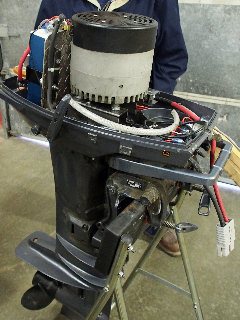
Question– Say, I’ve been digging around in my engine room getting ready for the upcoming boating season and I noticed something that seems weird to me on my engine’s muffler.
The black cylinder has what looks like an engine sending unit screwed into my muffler with two wires coming out of it. My engine is a diesel so I don’t think this is part of an emission control system. Any clue on this would be greatly appreciated.
Answer- What you are looking at is an important safety feature that most boat builders unfortunately leave out. You are indeed looking at a sending unit for an exhaust overheat alarm system. This overheat sensor is designed to sense excess heat build-up in your exhaust system in the event that the seawater pump that supplies cooling water to your exhaust system fails, which is a fairly common occurrence.
Many boat builders have felt, quite incorrectly, that the engine temperature gauge is adequate for monitoring this. This is simply wrong thinking as the response time for the engine coolant to run too hot in the event of pump failure is much longer than for the exhaust system to overheat in the event of a loss of cooling water.
The temperature difference is quite significant as well. Engine exhaust can run in excess of 1000°F as it leaves your engine. Coolant inside your engine is only running in the 150-220 °F range under normal conditions. It’s easy to understand that at 1000 degrees, things can and have historically caught fire on boats losing their exhaust cooling water, even for a brief period of time.
Early warning to shut down the affected engine and fix the pump is important to prevent a fire, which is why the ABYC incorporated the requirement for exhaust temperature sensing alarm systems into their standards many years ago. The only wish is that more boat builders would incorporate this feature into their engine installations.








